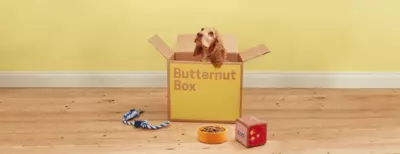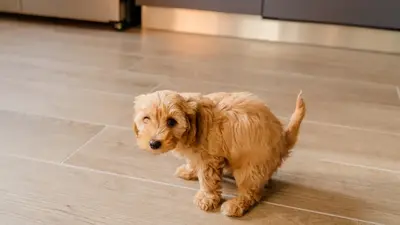How to Bathe a Puppy
- 22 Jan 2024
- 6m read
.webp)
Advice from our very own Butternut Box Ambassador, Meera. Meera is an IMDT qualified Dog Trainer specialising in puppy training and socialisation, across the Sheffield area.
Tips for a Puppy’s First Bath
Unlike gremlins, your puppy’s first bath is much more than an opportunity to see what type of chaos breaks loose when they get wet.
As your puppy’s first bath can set a precedent for the next 10-15 years of baths (no pressure then) it’s really important that bath time is safe, fun and enjoyable - for your puppy and for yourself. Here are my top tips to help you with this:
Make sure they can grip to the bath
Your puppy is probably going to look like Bambi on ice whilst standing in the bathtub. Their soft little paw pads don’t have much grip on them, and the surface of your bathtub might be really slippery. It’s important your puppy feels safe and comfortable whilst standing in the bath.
One way to do this is to pop an old towel into the bathtub for your puppy to stand on, or invest in an anti-slip bath mat. By doing this, you’ve already helped bath time become safer, which may also help your puppy to feel more confident at bath times.
Only use puppy shampoo
Because they're worth it. It might seem obvious, but only use puppy-specific shampoo for your puppy’s bath times. Human shampoo can cause skin irritation or burns to your puppy’s delicate skin and fur. Puppy shampoos’ are specifically formulated with a suitable pH for puppies, so please don’t be tempted to use anything else.
Check the temperature
Its getting hot in here... before your puppy gets into the bath, test the water first. Aim for warm water - but be careful it’s not too hot. If you’re not sure if the temperature is ok for your puppy, fill a shallow container with some water and encourage your puppy to splash about and play with it. If they seem happy to continue, that’s your temperature test.
Start from the bottom
Bottoms up! Sorry, I didn’t mean for you to get a drink, I actually meant this fairly literally. When bathing your puppy, start from the bottom of their legs and work your way up towards their adorable little pink bellies.
Most pups don’t like having their faces washed - so don’t traumatise them by waving the shower head in their face, especially if it’s their first bath. You also need to be careful that you never spray water directly into their ears, as this could contribute to, or cause, ear infections. Short of popping a shower cap onto your puppy, you could also dampen a flannel with warm water and your give pup a gentle wash around their face and ears.
Please don’t use shampoo around their delicate little snoots, and their floppy puppy ears.
When Can You Bathe a Puppy?
Unless your vet has advised you differently - especially if your puppy suffers from allergies or skin conditions, you can usually bathe your puppy a few days after bringing them home, aged 8 weeks and over. The first few days of bringing your puppy home are all about bonding and relationship building, it can be quite a shock to the system (puppy’s and yours) so take things easy and slowly for the first few days, making sure anything new that you introduce your puppy to - including baths, is done positively and carefully.
Unless your vet has advised you to the contrary, it is not recommended to bathe your puppy before eight weeks of age. This is because your puppy isn’t old enough to regulate their own body temperature, which puts them at risk of becoming unwell if they are bathed before eight weeks of age.
Lastly, something most puppy owners forget about, is the importance of scent. Smells are really important to puppies. If your puppy comes home smelling of their parents, littermates, and their breeder’s house, this can be comforting to them. Before you wash all those lovely (or stinky) puppy smells away it's a good idea to let your puppy roll around on a soft blanket for a day or two, so they can transfer familiar scents to something they can keep as a reminder of puppyhood - without stinking everyone else out.
How Often Should You Bathe a Puppy?
This really depends on your individual puppy and their grooming requirements.
If you have a Spaniel puppy, you may find that they regularly give themselves a mud bath during their daily walks. If you have a Doodle breed, you will likely need to spend more time brushing them rather than bathing them.
As a general rule of thumb, you could bathe your puppy once a month with puppy shampoo. If they do get dirty and need a wash, be careful not to shampoo them regularly - as this can strip their coats of natural oils, and contribute to dry or irritated skin.
I know some pups that only get a bath every quarter - and they tell me that even that is too often.
One big mistake that puppy owners make is to bathe their puppies after they’ve had liquid flea treatment applied. Yes - the flea treatment stinks. No, it’s not going to work if you apply it, and then bathe your puppy a day later, as you’ve essentially just washed it all off. Environmentally, this also isn’t a good idea, as the flea treatment ends up getting washed into water sources.
How to Make Bath Time Enjoyable for Puppies
It's really important that your puppy has a positive association with bath time. There are a few different things you can do to encourage this:
All games, no pain
Pick a couple of waterproof puppy toys, and turn bath time into a game. As long as it’s safe to do so, you can play a few gentle games in the bath with your puppy. Just be careful that your puppy doesn’t try to leap out of the bath.
Bathtime = snacktime
If your puppy is motivated by food, then why not take some small treats into the bathroom with you?
You could line them up on the side of the bath as a distraction for your puppy.
Equally, you could invest in a lick-mat with suction cups on the back. You could smear some of your puppy’s favourite foods, such as peanut butter, onto the lick-mat and stick it to the wall - perfect for your puppy to safely enjoy their snack time, whilst you carry on with their bath time.
Master the drying process
No one (not even me) likes the smell of wet dog. However, once bath time is over, drying your puppy can be a bit challenging due to the heat and the unfamiliar noise of your hairdryer.
Please don’t force your puppy to be fur-dried against their will, otherwise it may cause them to become fearful of bath time. To help with the post-bath drying routine, you may want to use a towel or a drying robe instead. Although you should still be prepared for your puppy to do zoomies around your house, dramatically launching themselves at the sofa or carpet, whilst rolling and rubbing their cleanliness over every available surface in a bid to bring their previous smells back to life.
I hope you’ve found this article helpful, and picked up a few tips to make your puppy’s bath time safe, fun and enjoyable!

.jpeg)


